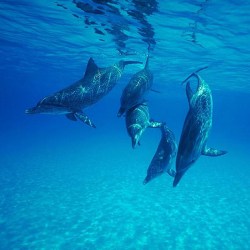Everything You Need To Know About Dolphins

Everyone has probably seen a dolphin by now, they are easy to recognise thanks to their curved mouths that make them seem as if they are permanently smiling. Dolphins can be found in every ocean and there are 36 species of dolphin. Most species tend to be marine which means they live in oceans or along the brackish waters of the coastlines. There are some species that live in freshwater streams and rivers, like the Asian river dolphin and Amazon river dolphin.
Diets and size
The largest species of dolphin known as the orca can grow to be as long as thirty feet whilst the smallest known as the Maui dolphin, is just five feet long. The dolphin diet consists mainly of fish and squid, which they hunt using echolocation which is essentially dolphin sonar. Dolphins send sound waves that bounces off their prey revealing everything they need to know, including location, shape and size. A dolphin using echolocation is able to make as many as one thousand clicks per second.
Language
Dolphins live in pods with numbers exceeding a dozen and the species is intensely social. These mammals communicate with one another using clicks, whistles and squeaks. Scientists have not confirmed whether these sounds are in fact a language and this debate over dolphin language has raged for decades. Like all mammals, dolphins are warm blooded animals and they nurse their offspring.
Partners and offspring
Dolphins will mate with more than one partner but in general produce a single offspring that remains with its mother for as long as six years, depending on the dolphin species. They are graceful sea creatures and sleek swimmers, able to achieve speeds exceeding 18 miles per hour. They tend to be very playful animals frolic in wakes and leaping out of the water besides boats. This behaviour is possibly to communicate or shed parasites.
Threats
Dolphins face a number of threats. They have been hunted for meat and blubber for centuries now. Today however the main threat faced comes from being accidently caught up in commercial fishing nets. The species must also rise to the surface to breathe regularly so this means when they get caught up in a net, they are prevented from doing this and they drown. Another threat faced by marine dolphins is a warming ocean temperature.
Climate change
Climate change has resulted in some primary sources of food to move into deeper water which is cooler. Another effect of warming temperatures and climate change is marine heatwaves and this has a negative impact on the reproductive abilities of dolphins and their ability to survive. Aside from being hunted or getting tangled in a fishing net, freshwater dolphins need to contend with the threat of dams which result in a degraded and fragmented habitat



